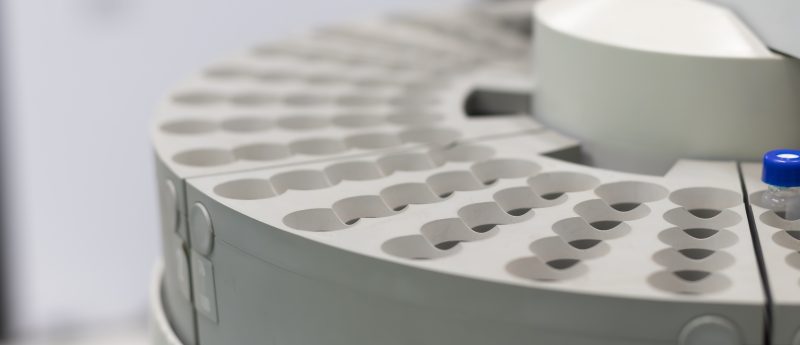The case for HILIC-SPE

 Robert MacNeill received his Bachelor’s degree with Honors in Chemistry from Heriot-Watt University then his MSc inanalytical Chemistry from the University of Huddersfield, both in the United Kingdom. Robert is also a Chartered Chemist and Member of the Royal Society of Chemistry. With 18 years of experience in all aspects of quantitative bioanalytical LC–MS/MS method development, nine of these years heading method development activities within HLS/Envigo, and a regular author and peer reviewer for the journal Bioanalysis, Robert is a recognized expert and innovator in the field.
Robert MacNeill received his Bachelor’s degree with Honors in Chemistry from Heriot-Watt University then his MSc inanalytical Chemistry from the University of Huddersfield, both in the United Kingdom. Robert is also a Chartered Chemist and Member of the Royal Society of Chemistry. With 18 years of experience in all aspects of quantitative bioanalytical LC–MS/MS method development, nine of these years heading method development activities within HLS/Envigo, and a regular author and peer reviewer for the journal Bioanalysis, Robert is a recognized expert and innovator in the field.
In his current role Robert coordinates all LC–MS method development and associated training, takes the lead in keeping abreast of innovation and technological development in the industry, coordinating in-house research projects and technical writing.
In this installment of Robert MacNeill’s (Envigo) column, Robert makes a case about endeavoring to incorporate orthogonal selectivity in a method even if it means exploring what might be viewed as unorthodox, as long as it’s scientifically sound and ultimately proven with adequate rigor.
The message I’d like to convey in this piece is, in essence, about endeavoring to incorporate orthogonal selectivity in a method even if it means exploring what might be viewed as unorthodox, as long as it’s scientifically sound and ultimately proven with adequate rigor.
The importance of orthogonality of selectivity has been illustrated in some detail previously in this column. In the field of quantitative bioanalysis using LC–MS detection, prior to the highly selective tandem mass spectrometric endpoint, there are two fundamental constituents of a given methodology in which selectivity should be selected appropriately and tuned. These are, of course, the biological sample extraction and the subsequent liquid chromatography. When the extraction is solid-phase it affords us the maximum potential to harness selectivity at this stage.
It’s important to keep in mind that orthogonal selectivity between the extractive and LC dimensions is an ideal. There are, meanwhile, innumerable instances of great methods that involve reversed-phase SPE complementing reversed-phase LC. There is still plenty of selectivity room within the reversed-phase domain for the production of rugged methodologies. For instance, the selection of reversed-phase chemistry in a stationary phase, pH and ionic strength of aqueous modifier, protic or aprotic organic modifier, are among the variables that contribute to an overall selectivity in a separation.
There are also innumerable instances of mixed-mode involving reversed phase with electrostatic interactions in the SPE complementing a reversed-phase LC, but not nearly so much the reverse, as it were. It would seem, therefore, that reversed-phase lends itself very well to bioanalysis, and it’s true enough. How often do we find HILIC in the LC dimension after any means of sample extraction? We would certainly like to, since it’s a wonderful complement to reversed-phase in terms of exemplifying truly orthogonal selectivity, and it’s conducive to high-sensitivity mass spectral detection due to the high-organic eluent composition. But the answer is not very often, even after SPE. One important reason for this is that HILIC often falls to pieces when biological extracts are injected, where solution injections, free of matrix residue, are unaffected. HILIC is simply not as forgiving as reversed-phase when it comes to the extent of disruption of chromatography due to small and unavoidable fluctuations, sample to sample, in injected sample composition.
However, this unforgiving aspect of the nature of HILIC pertains to the analytical chromatography, where any slight aberrations in parameters like asymmetry factor are justifiably seized upon, flagged and result in later reanalysis from scratch. What if, on the other hand, the HILIC was performed within the sample extraction dimension? Can such aberrations in band migration, like a bit of asymmetry, be forgiven? Yes, as long as we attain high and reproducible recoveries. We do not expect illustrious analytical chromatographic performance in the SPE dimension. There is good reason to suppose that this constitutes sound reasoning for involving HILIC, if it’s to be involved, at this stage rather than at the analytical LC stage.
As mentioned before in this column, I’m a big fan of the ubiquitous polymer-based SPE, but I also like to call for more commercial options with respect to SPE stationary phases that can be used for HILIC. These are overwhelmingly silica-based, since the naturally hydroxylated silica surface is a perfect means to invoke HILIC and can do so, albeit less uniformly and reproducibly, even in the presence of a hydrophobic bonded phase.
HILIC can also be performed on polymer-based phases though, as long as these are profoundly polar-modified and incorporate perma-charged moieties. In addition, returning to silica and its surface manifestations, it may be a fascinating prospect to have silica hydride-based columns translated to SPE format. This silica hydride surface chemistry bestows valuable characteristics whereby under high-acetonitrile conditions the aqueous normal phase mode is in operation, a mode somewhat akin to HILIC in its manifestation and selectivity.
It is nevertheless fundamentally distinct from HILIC in that, for one thing, the bonded phase on silica hydride does not need to be pronouncedly polar – and HILIC, on the other hand, is something that requires polar stationary phases. Under high aqueous conditions, it’s a reversed phase operation. Indeed bimodal separations are synonymous with silica hydride-based chromatography.
Wish lists aside, there are the means to do this commercially available, with reference mainly to silica-based SPE sorbents, most conducive to HILIC. It’s a case of trying it out, see how it works, but making sure the right fundaments are in place in the protocol. These are, for instance, loading acetonitrile-crashed plasma to avoid breakthrough due to too high an aqueous content in the HILIC load step, if a simple HILIC-SPE protocol is used (an alternative of mixed-mode employing HILIC is also feasible).
It is clear, in summary, how useful SPE is in obtaining orthogonal selectivity in quantitative bioanalytical LC–MS, amongst the other advantages of the technique. We can confidently attempt and optimize HILIC at the stage of SPE within a given method, where HILIC of extracts in the LC dimension may not work with adequate chromatographic reproducibility.
This article is part of Robert MacNeill’s (Envigo) quarterly column for Bioanalysis Zone which focuses on quantitative method design. You can read past installments of the column here.




